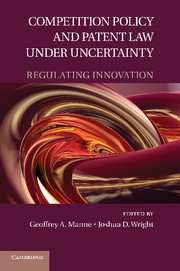Book contents
- Frontmatter
- Contents
- Contributors
- Introduction
- PART I THE INSTITUTIONS OF GROWTH
- PART II THE ECONOMICS OF INNOVATION
- PART III INNOVATION AND COMPETITION POLICY
- PART IV THE PATENT SYSTEM
- PART V PROPERTY RIGHTS AND THE THEORY OF PATENT LAW
- PART VI INTELLECTUAL PROPRETY AND ANTITRUST: THE REGULATION OF STANDARD-SETTING ORGANIZATIONS
- Index
Introduction
Published online by Cambridge University Press: 05 June 2012
- Frontmatter
- Contents
- Contributors
- Introduction
- PART I THE INSTITUTIONS OF GROWTH
- PART II THE ECONOMICS OF INNOVATION
- PART III INNOVATION AND COMPETITION POLICY
- PART IV THE PATENT SYSTEM
- PART V PROPERTY RIGHTS AND THE THEORY OF PATENT LAW
- PART VI INTELLECTUAL PROPRETY AND ANTITRUST: THE REGULATION OF STANDARD-SETTING ORGANIZATIONS
- Index
Summary
Innovation is critical to economic growth. While it is well understood that legal institutions play an important role in fostering an environment conducive to innovation and its commercialization, much less is known about the optimal design of specific institutions. Regulatory design decisions, and in particular competition policy and intellectual property regimes, can have profoundly positive or negative consequences for economic growth and welfare. However, the ratio of what is known to what is unknown with respect to the relationship between innovation, competition, and regulatory policy is staggeringly low. In addition to this uncertainty concerning the relationships between regulation, innovation, and economic growth, the process of innovation itself is not well understood.
The regulation of innovation and the optimal design of legal institutions in this environment of uncertainty are two of the most important policy challenges of the twenty-first century. The chapters in this book approach this critical set of problems from an economic perspective, relying on the tools of microeconomics, quantitative analysis, and comparative institutional analysis to explore and begin to provide answers to the myriad of challenges facing policy-makers. Any legal regime, after all, must attempt to assess the trade-offs associated with rules that will affect incentives to take risks, allocative efficiency, competition, and freedom of economic actors to commercialize the fruits of their innovative labors and foster economic growth.
- Type
- Chapter
- Information
- Competition Policy and Patent Law under UncertaintyRegulating Innovation, pp. 1 - 24Publisher: Cambridge University PressPrint publication year: 2011
- 1
- Cited by



